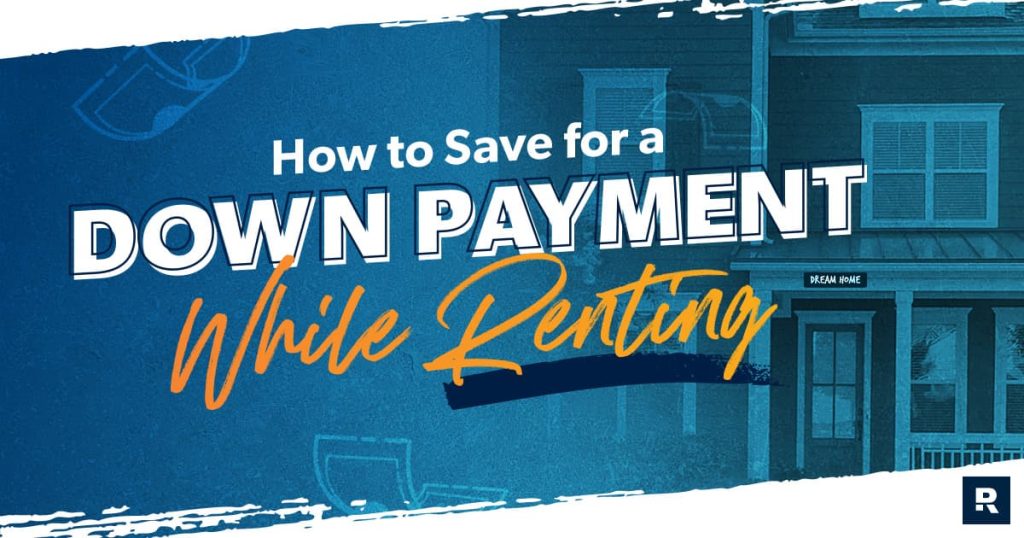It might feel impossible to save a down payment while renting. After all, rent is expensive! And it’s not getting any cheaper. The national median rent for a two-bedroom apartment is $1,374.1
So, how in the world are you supposed to save a down payment big enough to buy a house when more of your money keeps going toward rent every year?
Don’t worry. It is possible, and you can do it. Here’s the best way to save for a house.
How to Save a Down Payment While Renting: 9 Tips
1. Follow a budget.
Budgeting gives you the power to tell your money where to go instead of having to wonder where it went. It’s how you make money goals happen—like saving for a down payment.
Here’s how to make a budget that really works:
- Write down your monthly take-home pay.
- List your monthly expenses—including your monthly down payment savings goal.
- Make sure your income minus expenses equals zero.
- Track your spending (all month long).
- Make a new budget before the next month begins.
If you’re new to budgeting, it might take a few months to get it right, but hang in there—you’ll be a budgeting pro in no time. And you’ll be amazed at how much you can stash away each month toward your down payment savings goal.
Get this: On average, close to 10% of Americans’ monthly income goes toward debt payments.2 That’s a 10th of your income wasted paying for stuff from the past instead of going toward your future home!
Based on that stat, someone making $4,000 a month would send $400 of it to pay off debt on average—adding up to nearly $5,000 a year. But if they paid off their debt before saving for a house, they could put that $5,000 toward a down payment each year. That’s a huge difference!
Plus, adding a mortgage and other homeownership costs (like repairs and taxes) on top of debt can be a big financial burden. So be patient and keep renting until you’ve paid off 100% of your debt and saved a full emergency fund worth 3–6 months of your typical living expenses.
You can learn more about how to pay off debt with our free guide.
3. Get a roommate.
If you’re single and renting an apartment by yourself, this tip is for you. Remember how we said the national median rent for a two-bedroom apartment was at $1,374 Well, that’s barely $150 more than the median rent for a one-bedroom apartment ($1,220).3
So, instead of living alone, why not upgrade to a two-bedroom apartment for that extra $150, get a roommate, and split your rent costs in half? Based on the medians we just looked at, you’d go from paying over $1,200 on your own to paying about $687 with a roommate—a difference of $533 a month or $6,396 a year!
4. Move to a cheaper apartment.
Moving is never fun, but it could help you save a ton on rent and add thousands to your down payment savings over a year.
See how much house you can afford with our free mortgage calculator!
Take our imaginary bachelor friend Joel, for example. He currently lives in Franklin, Tennessee. He’s living his best life about 20 minutes from the live-music scene of downtown Nashville, but he wants to buy a house—and it’s hard for him to save while paying the higher rent prices that come with living in such a popular area.
So, Joel packs up his two-bedroom Franklin apartment and moves further south to the less crowded, more rural city of Columbia. Joel goes from paying rent of $2,925 in Franklin to paying $1,800 in Columbia.4,5 He can now save over $1,000 a month—more than $12,000 per year—toward his down payment goal.
If you’re like Joel and are renting in a popular (aka expensive) neighborhood, consider sacrificing some razzle-dazzle to live in an area with cheaper rent. Then, put the extra cash you pocket each month toward your down payment savings and watch it explode with growth!
5. Cut unnecessary spending.
Another way to boost your down payment savings is to cut back on expenses you don’t need. After you’ve reached your down payment goal, you can add those things back into your budget.
Here are some ideas on how to cut spending:
- Eat out less and buy generic-brand groceries.
- Replace vacations with staycations.
- Avoid buying new products and shop for used ones. (This doesn’t apply to toothbrushes and underwear.)
- Cancel some of your streaming services and stick with one or two (or even use some free ones).
- Trade your gym membership for free at-home workouts on YouTube.
6. Sell stuff.
No doubt you’ve got a bunch of stuff lying around your apartment or rental home that you don’t use anymore—so sell it! If you live in a high-traffic area, you could have a garage sale. Or you could sell online using platforms like Facebook Marketplace, Craigslist or eBay.
Here are some ideas on what to sell:
- Clothes
- Jewelry
- Books
- Blu-ray discs, DVDs and CDs
- Toys and games
- Home decor
- Furniture
- That guitar you never got around to playing
7. Start a side hustle.
If you really want to hit the gas on your down payment savings, pick up another job on the side. It doesn’t have to be anything fancy. You won’t be working there forever. Choose something simple you won’t totally hate doing after your day job.
Here are some side hustle ideas:
- Drive for Uber or Lyft
- Babysit
- Dog walk or pet sit
- Clean houses
- Sell products on Etsy
- Become a tutor
- Give music lessons
- Do freelance work on Fiverr
- Wash and detail cars
- Mow lawns or do yard work
- Shovel driveways
8. Save bonuses and raises.
Do you have opportunities for bonuses at your job? Maybe you’re in a role where you can increase your commissions the harder you work. Or you might be due for a raise. Whatever your job situation, another great way to save for a house while renting is to dedicate any extra money you earn at work toward your down payment goal.
Avoid the temptation to fall into the trap of lifestyle creep whenever your income increases—instead of using the money to increase your standard of living, throw it all into your house savings.
9. Avoid rent-to-own.
Before we wrap up, we have to shift gears here to warn you about rent-to-own homes. A rent-to-own home is a house you agree to rent for a few years before you buy it. The point is to lock in a house you want even if you can’t afford it yet.
You might be tempted to choose this option, but rent-to-own homes come with fees and other costs that wind up making them more expensive than traditional homeownership. That’s why our final tip for saving a down payment while renting is to avoid rent-to-own.
For example, with rent-to-own, you’ll pay a nonrefundable fee called option money. That’s the fee that gives you the option to purchase the house later. On top of that, your rent will likely be higher because some of it may go toward your future purchase as part of a built-in down payment.
You can start to see why this isn’t a great idea. Why fork over a whole bunch of extra money to lock yourself into a bad deal instead of just saving the money by yourself? What if you decide you don’t want to buy that particular house after the rental period is over? All the extra money you paid for the rent-to-own agreement would go bye-bye. Bad idea!
Instead, stick to a traditional rental agreement, skip rent-to-own fees, and save up your down payment using the other eight tips. You’ll be glad you did.
How Big of a Down Payment Do You Need?
As we wrap it up, there’s one last important question we need to answer: How much should you save for a down payment? Let’s break it down.
You should aim to put down at least 20% of the home price to avoid paying private mortgage insurance (PMI), an extra fee that runs about $75 a month for every $100,000 you borrow. A smaller down payment like 5–10% is okay for first-time home buyers, but be ready to pay PMI.
Whatever you do, never buy a house with a monthly payment that’s more than 25% of your take-home pay on a 15-year fixed-rate mortgage.
And though it may be tempting to use a mortgage with extremely low down payment requirement—like an FHA, VA or USDA loan—don’t do it. You’ll wind up with higher monthly payments, more debt overall, and tons of pointless fees.
Just keep these guidelines in mind, and you’ll be in really good shape. You’ve got this!
Read the full article here











